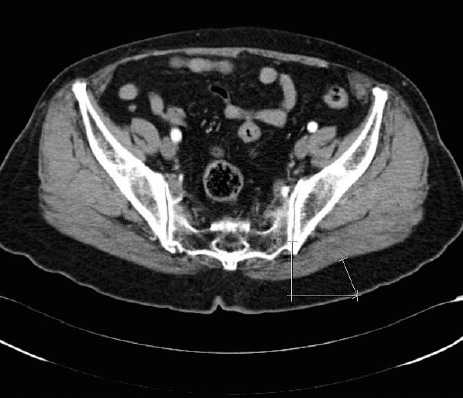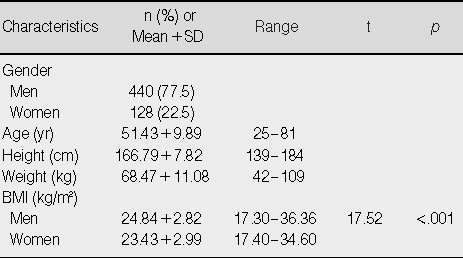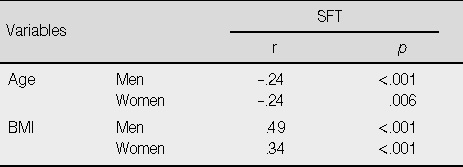Articles
- Page Path
- HOME > J Korean Acad Nurs > Volume 40(2); 2010 > Article
-
Original Article
- Gluteal Subcutaneous Fat Thickness Measured by Computed Tomography as an Estimate of Proper Gluteal Intramuscular Injections in Korean Adults
- Gaeul Joo, Kyeong-Yae Sohng
-
Journal of Korean Academy of Nursing 2010;40(2):247-254.
DOI: https://doi.org/10.4040/jkan.2010.40.2.247
Published online: April 30, 2010
1Research Assistant, College of Nursing, The Catholic University of Korea, Seoul, Korea.
2Professor, College of Nursing, The Catholic University of Korea, Seoul, Korea.
- Address reprint requests to: Sohng, Kyeong-Yae. College of Nursing, The Catholic University of Korea, 505 Banpo-dong, Seocho-gu, Seoul 137-701, Korea. Tel: 82-2-2258-7410, Fax: 82-2-2258-7772, sky@catholic.ac.kr
Copyright © 2010 Korean Society of Nursing Science
Abstract
-
Purpose
- To study the thickness of gluteal subcutaneous fat (SCF) and propose an adequate length for needle for gluteal intramuscular injections based on computed tomography (CT) measurements.
-
Methods
- The thickness of gluteal SCF were measured and studied for 568 patients who visited a tertiary hospital in Seoul, Korea between January 2007 and February 2009 for routine health screening and who had abdominopelvic CT.
-
Results
- The average thickness of gluteal SCF was 15.92±4.08 mm in males and 24.90±5.47 mm in females. The thickness of gluteal SCF differed significantly according to gender. The gluteal SCF thickness was greater than 20.4 mm for 54 (12.3%) of the 440 male patients and 99 (77.3%) of the 128 female patients.
-
Conclusion
- The most common syringe needle used for gluteal intramuscular injections in Korea is a 23 G, 25.4 mm-needle. The SCF thickness must be less than 20.4 mm in order to reach the dorsogluteal muscles to a depth of at least 5 mm if this 25.4 mm needle is used. In many patients, especially in female patients, the 25.4 mm needles will result in improper intramuscular injections with the injection being into the SCF. Therefore an appropriate needle should be selected by considering the gender and SCF thickness of patients receiving gluteal intramuscular injections.
This article is a revision of the first author's master's thesis from the Catholic University of Korea.
- 1. Beyea SC, Nicoll LH. Administration of medications via the intramuscular route: An integrative review of the literature and research-based protocol for the procedure. Applied Nursing Research. 1995;8:23–33.ArticlePubMed
- 2. Burbridge BE. Computed tomographic measurement of gluteal subcutaneous fat thickness in reference to failure of gluteal intramuscular injections. Canadian Association of Radiologists Journal. 2007;58(2):72–75.PubMed
- 3. Chan VO, Colville J, Persaud T, Buckley O, Hamilton S, Torreggiani WC. Intramuscular injections into the buttocks: are they truly intramuscular? European Journal of Radiology. 2006;58:480–484.ArticlePubMed
- 4. Cockshott WP, Thompson GT, Howlett LJ, Seeley ET. Intramuscular or intralipomatous injections? The New England Journal of Medicine. 1982;307:356–358.ArticlePubMed
- 5. Haramati N, Lorans R, Lutwin M, Kaleya RN. Injection granulomas. Intramuscle or intrafat? Archives of Family Medicine. 1994;3:146–148.ArticlePubMed
- 6. Hesby A, Nicoll LH. Intramuscular injection: An integrative research review and guideline for evidence-based practice. Applied Nursing Research. 2002;15:149–162.ArticlePubMed
- 7. Kim CS. A study on the practice of intramuscular injection of staff nurses working in a hospital. Journal of Human Science. 1984;8:87–93.
- 8. Kim MJ, Park HS, Choi SH, Sohng KY, Kim HS, Nam JJ, et al. Fundamentals of nursing. 2005;2nd ed. Seoul, Hyunmoonsa.
- 9. Kim SJ, Lee SO, Kim MJ, Park JH, Jin EH, Son JT, et al. Fundamentals of nursing. 2005;7th ed. Seoul, Soomoonsa.
- 10. Korea Centers for Disease Control and Prevention. Third national health survey results and in-depth analysis: health check up. 2007;04;Seoul, Author.
- 11. Korean Society for the Study of Obesity. The Asia-Pacific perspective: Redefining obesity and its treatment. 2006;02;Seoul, Author. (Original work published 2000).
- 12. Lenz CL. Make your needle selection right to the point. Nursing. 1983;13(2):50–51.Article
- 13. Lippert WC, Wall EJ. Optimal intramuscular needle-penetration depth. Pediatrics. 2008;122:556–563.PubMed
- 14. Mallett J, Dougherty L. Royal Marsden Hospital manual of clinical nursing procedures. 2000;5th ed. Oxford, Blackwell Science.
- 15. Analysis of 2007 Health Check Up Results. National Health Insurance Corporation data. 2009;01 06 Retrieved May 25, 2009. from http://www.nhic.or.kr/wbm/wbmc/wbmc_0400/wbmc_0405/wbmc_0405.html.
- 16. Newton M, Newton DW, Fudin J. Reviewing the big three injection routes. Nursing. 1992;22(2):34–41.Article
- 17. Nisbet AC. Intramuscular gluteal injections in the increasingly obese population: retrospective study. British Medical Journal. 2006;332:637–638.ArticlePubMedPMC
- 18. Poland GA, Borrud A, Jacobson RM, McDermott K, Wollan PC, Brakke D, et al. Determination of deltoid fat pad thickness. Implications for needle length in adult immunization. The Journal of the American Medical Association. 1997;277:1709–1711.ArticlePubMed
- 19. Rai S, Nandan N. Gluteal injections in increasingly obese population: Essential considerations for intramuscular injections. British Medical Journal. 2006;332:795.
- 20. Sohng KY, Park HS, Hong YH, Yun EJ, Lee KY, Cho BH, et al. Fundamentals of nursing II. 2008;Seoul, SooMoonsa.
- 21. Sohng KY, Park HS, Hong YH, Yun EJ, Lee KY, Cho BH, et al. Fundamentals of nursing Interventions and skills. 2009;Seoul, SooMoonsa.
- 22. Son JT, Jang EH, Ha NS, Lee HJ, Yang JH, Kim HM, et al. Fundamentals of nursing II. 2007;Seoul, Hyunmoonsa.
- 23. Zaybak A, Gunes UY, Tamsel S, Khorshid L, Eser I. Does obesity prevent the needle from reaching muscle in intramuscular injections? Journal of Advanced Nursing. 2007;58:552–556.ArticlePubMed
REFERENCES
Figure & Data
REFERENCES
Citations

- Efficacy of 1060 nm Diode Laser for Non-Invasive Subcutaneous Fat Reduction in Mini-Pigs
Yea-Jin Lee, Namgue Hong, Eun Seo Choi, Sun-Hyang Choi, Eun Young Kim, Hyeong Ju Park, Jin-Chul Ahn
Clinical, Cosmetic and Investigational Dermatology.2024; Volume 17: 2097. CrossRef - Analysis of gluteal subcutaneous and muscle thickness in infants and children for application to intramuscular injection, autologous fat grafting, and gluteal artery perforator flaps
Hyung Jun Min, Yu Jin Kim
Archives of Plastic Surgery.2018; 45(06): 550. CrossRef - Comment on the New Indian Injection Technique Recommendations: Critical Appraisal of the Real-World Implementation of the Current Guidelines
Felice Strollo, Sandro Gentile
Diabetes Therapy.2017; 8(3): 507. CrossRef - The Effect of Body Mass Index on Fluoroscopic Time and Radiation Dose During Sacroiliac Joint Injections
Daniel Cushman, Alexandra Flis, Ben Jensen, Zachary McCormick
PM&R.2016; 8(8): 767. CrossRef - Pharmacokinetic-Pharmacodynamic Study of Subcutaneous Injection of Depot Nandrolone Decanoate Using Dried Blood Spots Sampling Coupled With Ultrapressure Liquid Chromatography Tandem Mass Spectrometry Assays
Gurmeet K. S. Singh, Leo Turner, Reena Desai, Mark Jimenez, David J. Handelsman
The Journal of Clinical Endocrinology & Metabolism.2014; 99(7): 2592. CrossRef - The Appropriateness of the Length of Insulin Needles Based on Determination of Skin and Subcutaneous Fat Thickness in the Abdomen and Upper Arm in Patients with Type 2 Diabetes
Kang Hee Sim, Moon Sook Hwang, Sun Young Kim, Hye Mi Lee, Ji Yeun Chang, Moon Kyu Lee
Diabetes & Metabolism Journal.2014; 38(2): 120. CrossRef - Prediction of Optimal Gluteal Intramuscular Needle Length by Skinfold Thickness Measurements in Korean Adults
Dong-Won Choi, Kyeong-Yae Sohng, Bum-Soo Kim
Journal of Korean Academy of Nursing.2010; 40(6): 844. CrossRef

Figure 1
General Characteristics of the Participants (N=568)
Differences in Subcutaneous Fat Thickness between Gender (N=568)
SFT=subcutaneous fat thickness.
Correlation of Age and BMI with Subcutaneous Fat Thickness (N=568)
SFT=subcutaneous fat thickness; BMI=body mass index.
Regression of BMI with Subcutaneous Fat Thickness (N=568)
x=BMI; y=subcutaneous fat thickness.
Difference of Subcutaneous Thickness between BMI Groups (N=568)
*Scheffe's test.
SFT=subcutaneous fat thickness.
SFT=subcutaneous fat thickness; BMI=body mass index.
x=BMI; y=subcutaneous fat thickness.
*Scheffe's test.
 KSNS
KSNS
 E-SUBMISSION
E-SUBMISSION






 Cite
Cite

